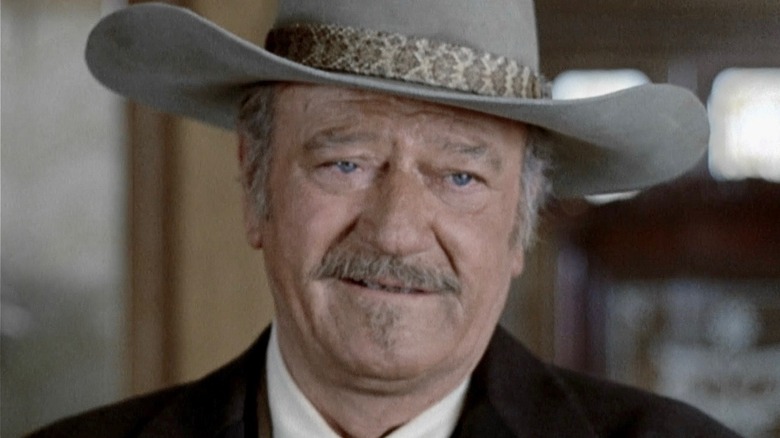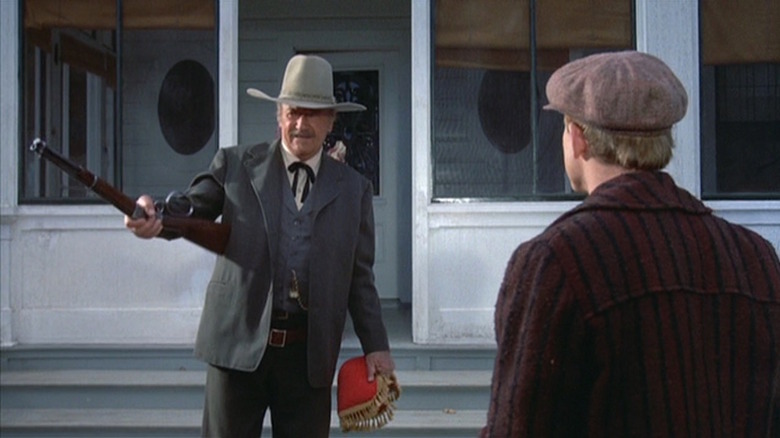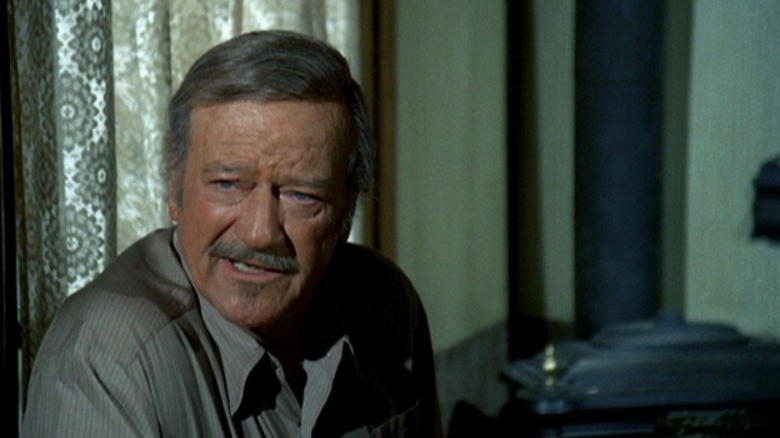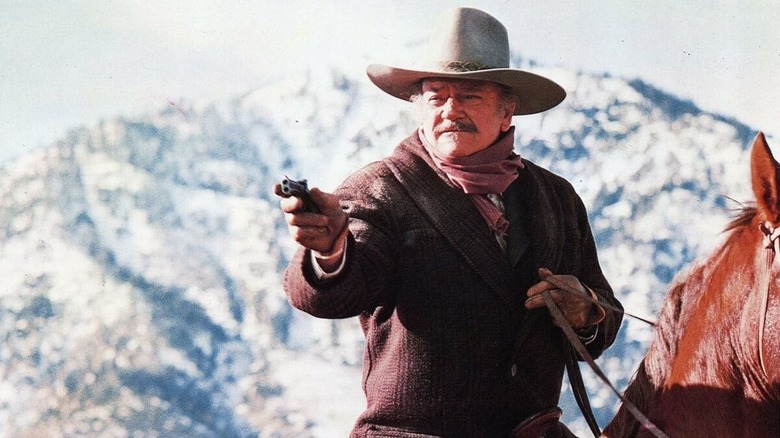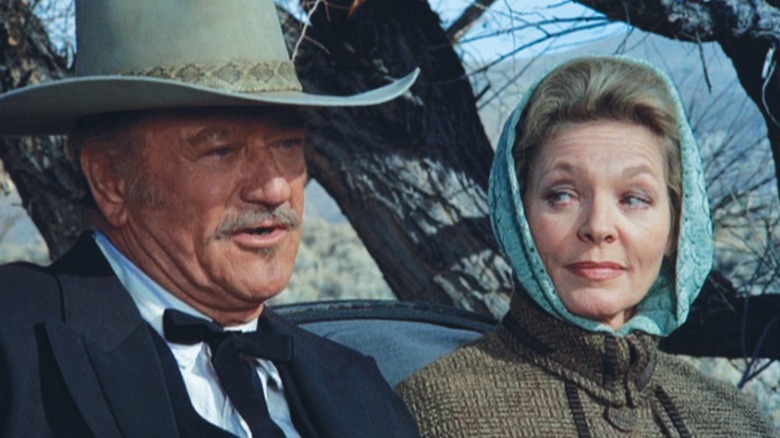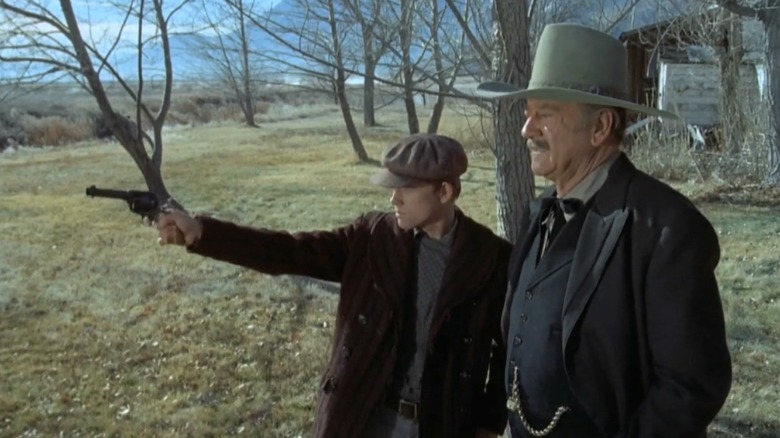John Wayne Fought A Constant Battle Behind The Scenes Of The Shootist
John Wayne spent nearly 50 years as a working actor in Hollywood, from the no-budget poverty row westerns of the '30s to ascendant, unprecedented stardom following his role in the 1939 John Ford classic "Stagecoach." He brought his sometimes-warm, sometimes-hostile persona to a number of film genres, but he's best associated with the western — after all, he was in many of the all-time greats.
In his final western, 1976's "The Shootist," the nearly 70-year-old Wayne had visibly aged. He certainly couldn't play characters like "The Ringo Kid" anymore. He couldn't even play the cranky middle-aged character type he developed through much of the '50s and '60s, macho guys like Cole Thornton in Howard Hawks' "El Dorado." Even though he insisted on doing his own stunts for 1971's "Big Jake," there was a shift in his presence in his final years. "The Shootist" took advantage of that, using the shadow of the John Wayne legend to contrast against the sick, elderly human being, who had begun having heart problems and stomach cancer according to Scott Eyman's biography "John Wayne: The Life and Legend."
But there were other issues. "The Shootist" was a far cry from the kind of western Wayne liked to make, or thought he made. Like so many '70s genre pictures, this would take the mythology of the past and subvert it. Don Siegel, the director, had big ideas for the movie. He and Wayne would not get along.
The legend
"The Shootist" begins with a veritable highlight reel of John Wayne westerns, as the bitter father figure of "Red River" and the beleaguered sheriff of "Rio Bravo." This montage, full of classic John Wayne shootouts, effectively functions as backstory for the hero of this movie, J.B. Books. More importantly, it places "The Shootist" explicitly in a continuum of John Wayne movies, playing a more subdued take on the character against our memories of him. Neither he nor the filmmakers knew this would be his last western, but the montage makes it feel inevitable.
Coming from Don Siegel, the filmmaker who had revolutionized the "urban vigilante" genre with the "Dirty Harry" series, this movie would be tough, but with enough light and humor to prevent it from being a depressing slog. Wayne had expectations too and liked to craft characters of a similar type. According to Scott Eyman's biography "John Wayne: The Life and Legend," the actor liked to play characters who have "a little more good than bad in him." It's no wonder he almost walked away from playing Ethan Edwards in "The Searchers."
For Wayne, J.B. was one such character. He has a tough hide, a violent past, but a tenderness that emerges in unlikely scenarios. When the old shootist, privately sick with cancer, ambles into turn-of-the-century Carson City, Nevada, he's an easy target. Aspiring gunmen vie for the chance to take on a legend.
Behind the scenes, that would be Don Siegel's job.
Script changes
According to "Duke: The Life and Times of John Wayne," his contract gave him final script approval for "The Shootist."
John Wayne could be demanding and dismissive behind the scenes. His decades in the business gave him experience and authority enough to know how to give the audiences what they wanted. He was protective of his image, evidenced by the control he exerted on 1969's "True Grit," which partly led to Mia Farrow's departure from the movie.
For "The Shootist," he wanted changes from Glendon Swarthout's original novel and the original draft of the screenplay. According to Scott Eyman, Wayne mostly took issue with the climax. The movie's relaxed pace gives room for Books to ruminate on his life, befriending young adult farmhand Gillom (Ron Howard) and his widowed mother (Lauren Bacall).
Wayne's image changed the ending
By the movie's end, his identity has been uncovered and many young gunmen are descending on the town. In the book, he takes out his assailants in a saloon, shooting one of them in the back before getting shot by the bartender. Now fatally wounded, he looks to Gillom to take him out of his misery.
Wayne didn't like shooting someone in the back, as it would look dishonorable. Nor did he like good guy Gillom performing an execution. Per Eyman, these factors led to him demanding and receiving script rewrites, the better to maintain his image. The movie would not have Books shooting anyone in the back, and Gillom would instead shoot the bartender responsible for Books' death.
Take after take
Besides taking charge of the narrative direction of the movie, John Wayne also just didn't like working with Don Siegel. Wayne had worked with some of the all-time American auteurs, like Howard Hawks and John Ford, as well as studio masters like Henry Hathaway. There was a slight generation gap between him and Siegel, best exemplified by the differences in Siegel's frequent lead actors Clint Eastwood and Wayne.
As Videomaker puts it, John Ford rarely did more than one take, and he liked the raw emotion and improvised dialogue that could come from it. The legendary director worked with Wayne over a dozen times (and on one uncredited television collaboration), effectively training Wayne on the art of filmmaking. Meanwhile, Siegel had come up in television, learning how to negotiate multiple camera setups to get coverage of a scene, and following the script to the letter.
Per Scott Eyman, Siegel would demand take after take from the ailing Wayne, once even getting into an argument with the actor and his scene partner James Stewart (playing the town doctor). Because Stewart had a hard time hearing his cues, he threw off Wayne's timing, causing the director to get frustrated.
Wayne flares up
"The Shootist" author Glendon Swarthout would be quoted in Scott Eyman's book as saying that Siegel "had a short man's complex" and "was a bit of a martinet." And as future director Ron Howard would recall to Eyman, Wayne had a number of "flare-ups."
Wayne's biggest flare-up was not due to any particularly demanding bit of direction from Siegel. It didn't involve being asked to do more takes than he could manage and it didn't have much to do with the story. Wayne just couldn't abide a particular camera setup. According to Howard, while shooting a scene in a barn, Wayne noticed the location of the camera: sitting in a bale of hay, pointed directly upward at him. Besides being an unflattering angle that would capture his nose and jowls, it was an ostentatious angle that drew attention to itself. He silently signaled for the camera operator to move the camera up, and then loudly told him to. Then he growled at Siegel to finally do the scene.
Besides that, Howard claimed they kept it professional until the end of the shoot. "They never kissed and made up, but both of them respected the work." Wayne might have grumbled and fought for control of the story (as well as the camera angles), but he and Siegel made an excellent film together. The union of director and star was contentious, but ultimately fruitful, as "The Shootist" is a touching elegy to a long-gone version of the Old West.
